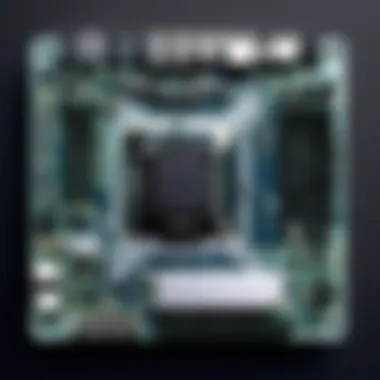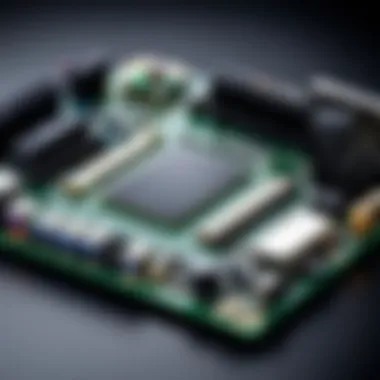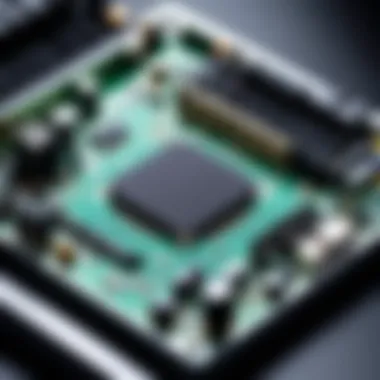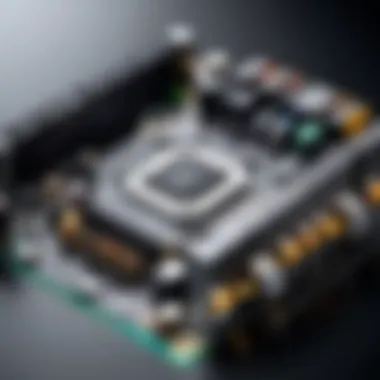Understanding Mini ITX Motherboards: A Comprehensive Guide


Intro
Mini ITX motherboards have gained popularity among enthusiasts and gamers due to their compact design and robust capabilities. The move towards more space-efficient builds does not compromise performance, making Mini ITX an attractive option for various applications. This guide aims to shed light on the specifications, advantages, and limitations of these motherboards, while also exploring their advantages in gaming and technology.
In recent years, the demand for high-performance hardware in smaller form factors has increased significantly. Gamers and tech aficionados often seek powerful solutions for their setups. Understanding how Mini ITX motherboards fit into this landscape is crucial for making informed decisions. The article provides insights into compatibility issues, key features to look for, and upcoming trends in this continually evolving field.
Key Points Discussed
- Specifications and Features: A breakdown of what defines a Mini ITX motherboard, including layout, ports, and supported components.
- Advantages: Information on the benefits of using these motherboards, such as space-saving and heat management.
- Limitations: Discusses potential downsides, particularly concerning expandability compared to larger form factors.
- Applications: How these motherboards are utilized in various scenarios, including gaming and professional setups.
- Future Trends: A look at upcoming advances and technologies that may influence the Mini ITX market.
Through this detailed exploration, readers will gain a nuanced understanding of Mini ITX motherboards and their place in modern computing. This knowledge not only aids in hardware selection but also empowers users to stay updated with technological advancements.
"The efficiency of Mini ITX builds is unearthly, perfect for the gamer on the go or the compact setup in need of power."
As we move through the sections, we will examine crucial components, trends, and insights that can enhance the overall computing experience.
Intro to Mini ITX Motherboards
Mini ITX motherboards are critical components in the realm of compact computing solutions, specifically catering to users who prioritize performance in smaller form factors. Understanding these motherboards empowers technology enthusiasts and gamers to make informed hardware decisions as they embark on building or upgrading their systems. Mini ITX boards, which measure just 6.7 inches square, offer a unique blend of performance and efficiency, making them suitable for a variety of applications.
One of the essential benefits of Mini ITX motherboards is their ability to fit into small cases. This enables a more space-efficient build without sacrificing critical functionality. Their reduced footprint facilitates the creation of systems that can be deployed in constrained environments, such as small desks or portable gaming stations. Moreover, these motherboards often support a range of powerful components, allowing users to customize and optimize their systems according to specific needs.
When discussing Mini ITX motherboards, several considerations arise. Users need to assess their requirements, such as the intended use of the system or the compatibility with specific hardware components. The distinctive characteristics of Mini ITX boards include their limited expansion capabilities, which can impact future upgrades and performance potential. Therefore, it is crucial to grasp the intricacies of these boards to ensure compatibility with other system parts and expected use scenarios, especially for demanding applications like gaming or content creation.
In summary, the section on Mini ITX motherboards serves to elucidate their significance in today's technological landscape. It sets the stage for a deeper exploration into their defining features and historical background—an exploration that will help readers appreciate the complexities and possibilities these boards present.
"Understanding the specifics of Mini ITX motherboards allows for smarter choices and better performance in compact builds."
Defining Mini ITX
The term "Mini ITX" originates from the motherboard's size and specifications, governed by the standards established by VIA Technologies in 2001. The format is known chiefly for its dimensions, measuring 17 cm x 17 cm, making it compact compared to traditional ATX boards. Mini ITX motherboards typically include the essential components required for system operations, such as the CPU socket, memory slots, and various connectors. Users benefit from their layout that is specifically optimized for small cases, which usually leads to less clutter and potentially improved airflow.
Historical Context
The evolution of Mini ITX motherboards correlates closely with the growing demand for compact and efficient computing solutions. Since their introduction, they have catered to a niche market that values mobility and space conservation. Early implementations of Mini ITX boards primarily targeted home theater PCs and small office environments, where performance and aesthetics needed to be balanced within tight spatial constraints. As technology progressed, Mini ITX boards began attracting gamers and content creators, leading to enhancements in their design and functionality.
Notable developments include the integration of more powerful CPUs and advanced cooling solutions, which have significantly expanded the capabilities of these boards. Today, various brands produce Mini ITX motherboards, each catering to specific audiences—ranging from casual users to serious gamers—each contributing to the sector's ongoing evolution.
Specifications of Mini ITX Motherboards
In the realm of compact computing, understanding the specifications of Mini ITX motherboards is crucial for both performance and compatibility. These specifications dictate not only the capabilities of the motherboard but also its integration with other components. The focus here is on physical size, power requirements, and other crucial features. With knowledge in hand, enthusiasts can make informed choices that enhance their builds.
Physical Dimensions
The standard dimension for Mini ITX motherboards is 6.7 inches by 6.7 inches (170 mm x 170 mm). This compactness allows them to fit in smaller cases, making them a popular choice among users with space constraints. Due to their size, Mini ITX motherboards often sacrifice some expansion potential when compared to ATX boards. However, many models come equipped with features that maximize functionality without increasing the board size dramatically.
The importance of the physical dimensions cannot be understated. A smaller footprint means lighter systems, which is advantageous in transport situations, especially for gamers who attend esports events.
Power Connectors
Power connectors on Mini ITX motherboards are essential for delivering energy to components efficiently. Most Mini ITX boards use a 24-pin ATX power connector, which is standard for many desktop motherboards, ensuring compatibility with various power supplies. Some boards may also feature a 4-pin or 8-pin CPU power connector.


Understanding the power requirements is crucial for proper assembly. A motherboard with insufficient power input or non-standard connectors may lead to performance issues or damage. Thus, selecting a power supply that is appropriate for the Mini ITX motherboard is highly advisable.
Memory Slots
Typically, Mini ITX motherboards feature two DIMM slots. This limitation can impact users who require higher memory capacities as dual-channel setups yield better performance. However, for many gaming and general use applications, 16GB to 32GB of RAM can still be more than adequate.
It is vital to choose the right type of memory, such as DDR4, based on motherboard specifications. A mismatch can lead to functionality issues or underperformance.
Expansion Slots
Expansion slots on Mini ITX motherboards are where users can add additional components, such as graphics cards or sound cards. Many boards come equipped with one PCI Express x16 slot. This is sufficient for a dedicated GPU, which is essential for gaming and high-performance tasks. However, due to limited space, extensive options for adding multiple GPUs are rare.
Users planning to future-proof their setups must carefully consider their needs against these expansion slots. While expansion may be limited, modern GPUs provide significant power, making a single slot often enough.
Storage Interface Options
Storage interface options on Mini ITX motherboards commonly include SATA III ports and M.2 slots. The M.2 interface is particularly valued for its speed, allowing for NVMe SSDs that dramatically improve data read and write times compared to traditional hard drives.
For compact builds, it's crucial to assess the number of storage connections available. While a limited number of SATA ports may be present, the use of M.2 can help maximize storage without requiring additional space.
Advantages of Mini ITX Motherboards
Mini ITX motherboards have gained prominence in recent years, particularly among technology enthusiasts and gamers looking for the optimal balance between performance and compactness. Their design accommodates powerful hardware without the need for extensive space, making them suitable for a variety of use cases. Understanding the advantages of Mini ITX motherboards provides insight into why they are a popular choice in modern computing.
Space Efficiency
One of the most notable advantages of Mini ITX motherboards is their space-efficient design. Measuring just 6.7 x 6.7 inches, these boards fit into smaller cases, freeing up valuable desk space. This is particularly beneficial for users in urban environments and those with limited room for traditional towers. The compact nature of Mini ITX systems allows for more streamlined setups, integrating seamlessly into various environments.
Moreover, smaller builds naturally promote better cable management. With less space to navigate, users tend to focus on organizing components properly. This leads to improved airflow within the case, which can enhance thermal performance. Consequently, a well-placed Mini ITX setup can ensure both aesthetics and functionality in a constrained area.
Lower Power Consumption
Another advantage of Mini ITX motherboards is their often lower power consumption. These boards frequently host a limited number of components compared to their full-sized counterparts. A smaller footprint means fewer power-hungry components are included in the system, which can significantly reduce overall power draw. For users conscious about energy consumption, this can lead to a more sustainable computing experience.
Lower power usage also translates into less heat generation. This allows users to explore passive cooling solutions more effectively. Consequently, fans may be less necessary, leading to quieter operation overall. For gamers and tech aficionados, this is crucial as unwanted noise can detract from the immersive experience.
Cost-effectiveness
Cost-effectiveness is also a significant factor when considering Mini ITX motherboards. While a variety of factors determine total costs, the ability to build a system in a smaller format typically leads to savings. Smaller cases and components often come at a reduced price, making it easier for budget-conscious users to invest in a capable setup.
Additionally, the trend toward miniaturization in the tech industry means powerful components are now available that specifically target smaller builds. Thus, enthusiasts can assemble high-performance systems without stretching their budgets excessively.
"Opting for a Mini ITX motherboard could be the key to a compact, powerful gaming experience without compromising on essential features."
Combining these elements – space efficiency, lower power consumption, and cost-effectiveness – makes Mini ITX motherboards a compelling choice in today's market.
Limitations of Mini ITX Motherboards
Mini ITX motherboards are popular for compact PC builds, especially among gamers and tech enthusiasts. However, they come with some limitations that can impact overall performance and customization. Understanding these limitations is crucial for making informed decisions when choosing components for your system. Below, we will focus on specific aspects of Mini ITX motherboards that could be considered drawbacks.
Limited Expansion Options
One of the most significant limitations of Mini ITX motherboards is their restricted expansion capability. Unlike larger form factors such as ATX or microATX, Mini ITX motherboards typically have only one PCIe slot. This slot can accommodate a dedicated graphics card, but the lack of additional slots limits options for adding more components.


"The restricted expansion options make it challenging to include features like additional GPUs or specialized sound cards, which can be a dealbreaker for some users."
Given that many users are looking to build powerful gaming systems or workstations, this single-slot limitation can be a considerable disadvantage. If you need multiple GPUs for gaming or heavy workloads, consider larger alternatives. Additionally, the number of RAM slots is often limited to two. This means that users who wish to expand memory in the future will face challenges.
Thermal Constraints
Another limitation comes from thermal management. Mini ITX setups are compact and have less airflow compared to larger systems. Heat dissipation might become a critical issue, especially under load conditions. Powerful components generate a lot of heat, and in a tight space, it can lead to thermal throttling.
To mitigate thermal problems, users may need to invest in higher-quality cooling solutions or specialized case fans. However, these solutions can take up extra space, which some cases might not have. Furthermore, if you plan to overclock, you will need to choose motherboards and CPUs that manage heat well. Failure to do so can significantly affect performance and stability.
Compatibility Issues
Lastly, compatibility can be a concern with Mini ITX motherboards. Users might find it complicated to select components that fit properly within the limitations of their chosen case and motherboard. Not all CPU coolers, graphics cards, or additional hardware fit within the confines of Mini ITX specification.
When building a system, it is essential to check not only the dimensions but also the height restrictions imposed by the case. Some Mini ITX cases are designed for portability and have less room for larger components. Users should closely examine technical specifications to avoid potential mismatches, which could require further modifications or result in costly returns.
In summary, while Mini ITX motherboards provide unique advantages like space-efficiency, their limitations in expansion, thermal management, and compatibility need careful consideration. Understanding these constraints can lead to more satisfying and effective builds, preventing frustration during later stages of the development process.
Popular Brands and Models
Understanding the landscape of Mini ITX motherboards requires an exploration of the leading brands and models. This section elucidates how brand reliability and model specifications contribute to choosing the best Mini ITX solution. Recognizing the strengths of notable manufacturers can guide users toward fulfilling their performance needs while ensuring compatibility with other components. Each brand brings its unique features and innovations, helping you weigh your options in this competitive market. Here, we will discuss ASUS and MSI, two frontrunners in the Mini ITX motherboard space.
ASUS Mini ITX Offerings
ASUS stands as a prominent player in the motherboard industry, particularly with its Mini ITX offerings. Their boards are known for high-quality manufacturing and a strong emphasis on features that cater to gamers and performance enthusiasts. Models such as the ASUS ROG Strix X570-I Gaming and ASUS Prime 70-I are particularly noteworthy.
These motherboards incorporate advanced technologies such as PCIe 4.0 support, ensuring maximum bandwidth for high-speed component interaction. Furthermore, ASUS incorporates robust thermal management solutions, crucial for maintaining performance under high loads. The BIOS interface is exceptionally user-friendly, appealing to both new and experienced builders. Users can have better control over their systems, adjusting settings for optimal performance. With a strong reputation for durability and performance, choosing an ASUS Mini ITX motherboard often results in a well-rounded build.
MSI Mini ITX Lineup
MSI is another key competitor in the Mini ITX market, providing solutions that balance aesthetics and functionality. Models like the MSI MPG B550I Gaming Edge WiFi and MSI Z490I Unify feature an array of supporting technologies tailored for gaming and multitasking.
MSI frequently includes Mystic Light RGB features in their boards, allowing custom visualizations for a more personalized setup. However, beyond visually appealing designs, their motherboards excel in power delivery and heat dissipation, which are both crucial for performance during intense gaming sessions.
Overall, MSI stands out with its strong focus on gamers' needs. Each model offers excellent build quality, comprehensive connectivity options, and effective thermal solutions. This results in a compelling choice for those looking to create a powerful yet compact gaming rig.
"Choosing the right brand and model is essential for maximizing your Mini ITX build's performance and longevity."
Examining the popular brands and their respective models allows you to navigate through existing options sensibly, ensuring that your investment aligns with your performance demands and aesthetic preferences.
Choosing the Right Mini ITX Motherboard
Selecting the appropriate Mini ITX motherboard is critical for building a compact yet powerful system. The right choice can enhance performance, optimize resource allocation, and ensure compatibility with various components. Given the constrained space in Mini ITX cases, where every element must fit efficiently, this decision impacts the overall effectiveness of the system greatly. A careful evaluation of both personal needs and specific motherboard characteristics will help craft a build that meets performance expectations while maintaining a compact design.
Assessing Your Needs
Before diving into the specifications of Mini ITX motherboards, it’s essential to assess your personal needs and intended use cases. Are you building a gaming rig, a powerful workstation for content creation, or a simple home office system? Each application has different demands.
- Performance: If gaming is your focus, you may need a motherboard that supports high-performance CPUs and GPUs, offers multiple M.2 slots for quick storage, and includes extensive connectivity options.
- Future Upgradeability: This is crucial if you want to extend the life of your build. Opt for a motherboard that provides adequate expansion possibilities despite the compact form factor. Look at RAM slots and any support for up-to-date technology.
- Size Limitations: Ensure that the motherboard fits within your selected case along with other components. Some Mini ITX cases may impose constraints that further dictate compatible hardware selections.
Ultimately, understanding your requirements aids in aligning your motherboard choice with the goals of your build.
Budget Considerations


Budget plays a significant role in selecting the right Mini ITX motherboard. A clear understanding of financial limits helps in narrowing down options without compromising essential features.
- Prioritize Features: Determine which features are non-negotiable. For instance, if you need high RAM capacity or support for advanced connectivity like Wi-Fi 6, allocate more budget for these specifications.
- Balance Cost and Performance: Motherboards vary widely in price. You might find an entry-level board sufficient for everyday tasks, while gamers or professionals may need a higher-end model that supports overclocking, enhanced power delivery, and superior cooling solutions.
- Potential for Additional Costs: Don’t forget that investing in a motherboard may also imply future costs. Consider compatibility with existing components and the potential need for new accessories or upgrades.
A well-planned budget will ensure a satisfactory selection process, helping you achieve the desired balance between performance and cost-efficiency.
Building with Mini ITX
Building with Mini ITX motherboards offers a unique experience for technology enthusiasts and gamers. The compact design of these motherboards presents both challenges and opportunities. For those who prioritize performance and a small footprint, understanding how to effectively select and utilize Mini ITX components is essential.
Component Compatibility
When considering a Mini ITX build, component compatibility becomes a key factor. Mini ITX motherboards have limited space, which means not all components will fit as desired. Here are some considerations:
- CPU Socket Compatibility: Ensure the CPU you choose matches the socket type on the motherboard. Different generations of processors often use different sockets, so research this deeply.
- RAM Compatibility: Mini ITX boards usually have two RAM slots. It is crucial to consider the maximum supported RAM and its speed. Dual-channel configurations can enhance performance, hence choosing compatible RAM is important.
- Graphics Card Size: The GPU you select must physically fit within the case alongside the other components. Always check the maximum GPU length spec of the motherboard and case.
- Power Supply Requirements: Ensure the power supply unit provides enough wattage for all components. Some Mini ITX setups may require SFX power supplies due to confined space.
Cooling Solutions
Effective cooling is critical for the long-term performance of any build, and even more so in Mini ITX configurations where airflow can be restricted. Consider the following cooling solutions:
- Air Coolers: Low-profile air coolers can be a good option. These are designed specifically for compact builds and can fit into smaller cases without blocking RAM slots.
- Liquid Cooling: AIO (All-in-One) liquid coolers can offer great thermal performance without taking too much space. They can provide efficient heat dissipation while maintaining a sleek look.
- Case Fans: Ensure there is adequate airflow in the case. Adding one or two case fans can significantly improve thermal management. Look for fans that fit the case and provide a good balance between airflow and noise.
- Thermal Paste: Use quality thermal paste during the CPU assembly. This small step can greatly affect cooling performance.
Remember that maintaining optimal temperatures is essential not just for performance, but for the longevity of the hardware.
Future Trends in Mini ITX Technology
The landscape of Mini ITX motherboards is rapidly evolving, influenced by both technological advancements and shifts in consumer demand. As users increasingly seek high-performance solutions in compact forms, understanding these future trends is essential. Companies are focusing on making Mini ITX boards more powerful without sacrificing their small footprint.
Advancements in Performance
One key area of advancement lies in performance improvement. Mini ITX motherboards are integrating newer chipsets that offer better processing capabilities. These improvements are not only about speed but also about efficiency. Enhanced energy management features allow users to maximize performance without overwhelming power consumption.
With the advent of PCIe 4.0 and soon PCIe 5.0 standards, users can expect faster data transfer rates. This is crucial for applications like gaming and content creation, where speed matters significantly. Moreover, improved graphics support allows for better GPU integration even in smaller builds.
Motherboard manufacturers are also focusing on better thermal solutions, meaning that even in cramped environments, heat management is becoming more effective. Advanced designs enable streamlined airflow, crucial for maintaining system stability under load.
Market Demand and Evolution
Consumer preferences are shifting, driving manufacturers to innovate continuously. The demand for gaming and compact PCs has surged, prompting a rise in ultra-compact builds. Users desire systems that not only perform well but also take up minimal space. This demand leads to innovations in design, making Mini ITX boards more appealing to a broader audience, including non-gamers.
Additionally, as mobile computing remains on the rise, the relevance of Mini ITX motherboards is likely to increase. Firms are exploring hybrid models that combine features of Mini ITX with direct mobile integration capabilities. This means future Mini ITX motherboards might provide more seamless connectivity with various mobile devices.
In summary, the future of Mini ITX technology is marked by enhanced performance capabilities and an evolving market landscape. As these trends continue, enthusiasts and casual users alike will benefit from more powerful, compact solutions.
The End
Understanding Mini ITX motherboards is essential for anyone interested in building compact yet powerful computer systems. This article has explored the core aspects of these motherboards, covering specifications, advantages, limitations, and popular brands. Each of these elements plays a crucial role in the decision-making process for technology enthusiasts. By thoroughly examining each component, readers can gain insights that aid in optimizing their builds.
Given the rise in demand for space-efficient solutions in technology, Mini ITX motherboards present a compelling choice for both gamers and general users. They offer a blend of high performance and space-saving design, making them perfect for smaller setups without sacrificing power. Some advantages include lower power consumption, which is critical in today’s eco-conscious environment.
Summarizing Key Points
- Specifications Matter: Understanding the physical dimensions and connectivity options of Mini ITX motherboards can influence compatibility with other components.
- Advantages Are Compelling: Space efficiency and lower power usage make them an attractive option for users looking for minimalistic designs.
- Limitations Exist: Users must be aware of potential thermal constraints and limited expansion options that may affect long-term usability.
- Market Trends: Staying informed on the latest developments in this technology is important for making well-rounded decisions regarding new purchases.
"Mini ITX motherboards represent a significant segment in the computing world, especially for those keen on building efficient systems."
Final Thoughts
For those engaged in esports or serious gaming, the choice of motherboard becomes even more critical. A suitable Mini ITX option can ensure that every component works effortlessly together, providing users with the performance and reliability needed in competitive environments. Moreover, it's essential to regularly check for updates on new models and technologies to remain ahead in the game. Overall, understanding Mini ITX technology equips users with the knowledge to create systems that are both powerful and compact.



